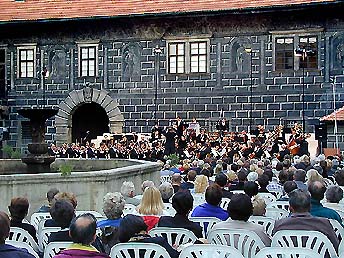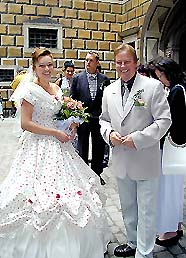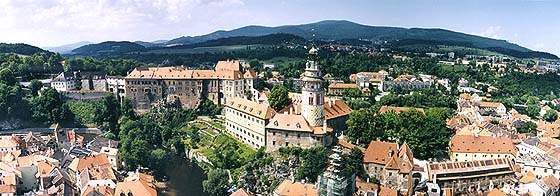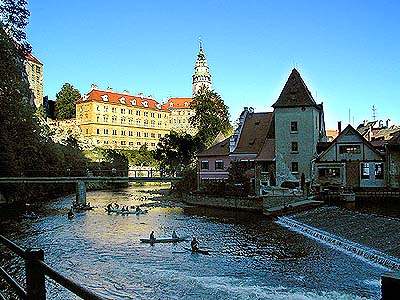Český Krumlov Castle in the 20th Century
 At the beginning of the
20th century, Prince Adolf Joseph zu Schwarzenberg (1832-1914)
began to consider the reconstruction of Český Krumlov Castle. In
1900, in view of the castle\'s cultural and historical importance,
he decided to open some of the Schwarzenberg staterooms to the
public. In 1909, restoration work began of the paintings in the
Masquerade Hall, castle courtyards (IIIrd
Courtyard of Český Krumlov Castle, IVth
Courtyard of Český Krumlov Castle) and frescos in the
Renaissance rooms which had been whitewashed in 1748. The work was
entrusted to artist Theofil Melichar from Vienna whose techniques,
however, produced heated disputes among experts.
At the beginning of the
20th century, Prince Adolf Joseph zu Schwarzenberg (1832-1914)
began to consider the reconstruction of Český Krumlov Castle. In
1900, in view of the castle\'s cultural and historical importance,
he decided to open some of the Schwarzenberg staterooms to the
public. In 1909, restoration work began of the paintings in the
Masquerade Hall, castle courtyards (IIIrd
Courtyard of Český Krumlov Castle, IVth
Courtyard of Český Krumlov Castle) and frescos in the
Renaissance rooms which had been whitewashed in 1748. The work was
entrusted to artist Theofil Melichar from Vienna whose techniques,
however, produced heated disputes among experts.
Prince Johann Nepomuk (1860-1938), the new ruler, had to face the establishment of the independent Czechoslovak State abolishing aristocratic privilege and the economic consequences of laws on land reform, completed in the year 1931 ,which led to the loss of the Schwarzenberg\'s vast land funds, goods, forests and industrial enterprises.

|

|
In the year 1939, the last representative of the family, JUDr.
Adolf zu Schwarzenberg (1890-1950) went into exile, and in 1940 the
Gestapo confiscated the property of the Schwarzenberg family. After
the war, in May 1945, The Czech National Administration was
established. In 1947, the Act No.143/47 Col. "Lex" Schwarzenberg
came into force and the property of the Schwarzenberg primogeniture
located in the Czech territory was passed to the Lands of Bohemia.
After abolition of provincial system in 1950 the property
definitely became the possession of the Czechoslovak State and the
State Heritage Authority in Prague, which began inventory of
tangible property, took charge of the castle. Pursuant to the Act
No. 22/58 Col. on historic monuments the Regional Centre of State
Heritage Authority took charge of the property; from the beginning
of the 1960\'s to 1972 the State Castle Český Krumlov was in
administration of District National Committee in Český Krumlov,
then it returned to the administration of Regional Centre of
Heritage Authority and Nature Protection. The Ministry of Culture
of the Czechoslovak Republic established the State office for
protection of monuments in České Budějovice, pursuant to the Act
No. 20/87 Col., in force from 1 January 1991. From that time on the
State office for protection of monuments in České Budějovice
enforces the right to manage the national property including the
Administration of Český Krumlov Castle.

|

|
The Czechoslovak State opened the castle gates to the public.
However, the maintenance of the castle complex required huge
amounts of financial means and the castle began falling into
disrepair to due lack of such funds. Many domestic and foreign
experts were well aware of the unrivalled status of this monument.
The Český Krumlov Castle gained the highest historic monuments
preservation status - in 1963, the town was declared to be a Town
Preserve; in 1989 the castle became a National Monument; in 1992,
the complex was included onto the list of UNESCO World Cultural
Heritage Monuments. The castle is open to public and the most
imposing interiors and exteriors can be visited at the present
time. Within the two guided tours (No.I
Guided Tour of Český Krumlov Castle, No.II
Guided Tour of Český Krumlov Castle) in the upper part of the
castle visitors can be acquainted with original historic interiors
dated from the 16th, 18th and 19th centuries that were
reconstructed according to the period inventory and iconographic
materials. The castle tower with a gallery (Castle
No. 59 - Castle Tower) and the adjacent premises of the Little
Castle are open to the public as well. Exhibition halls housed in
the building of Mint (Castle
No. 59 - Mint) and Dairy (Castle
No. 59 - Dairy) in the IInd courtyard offer thematic
exhibitions from the castle depository during the season. The four
storeys of the Gothic and Renaissance Cellars
in the IVth Courtyard of Český Krumlov Castle accommodate an
exposition of international ceramics. The interior tour of the
re-opened Baroque Castle
Theatre in Český Krumlov where trial tours are running is
immensely interesting. Over forty buildings and palaces situated
around five castle courtyards as well as the extensive Baroque park
are available for exterior tours (Tourist
Service within the Český Krumlov Castle Complex).
The programme of tours is carried out in parallel with many cultural and social activities that take place during the whole season. Its tradition has already established four festival projects, dozens of evening concerts and performances, opening days of exhibitions, international congresses, symposia or seminars and other Cultural and Social Activities at Český Krumlov Castle.
It is the Restoration of Český Krumlov Castle - now and in the near future which focuses on the maintenance and enhancement of the originality of the castle complex that is the paramount task of the Administration of Český Krumlov Castle and other co-operating institutions, the operator - Ministry of Culture of the Czech Republic and the administrator State office for protection of monuments in České Budějovice.
See also:
History
of Český Krumlov Castle
(mh)



